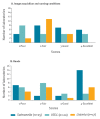Evaluation of molecular typing of foodborne pathogens in European reference laboratories from 2012 to 2013
- PMID: 28006653
- PMCID: PMC5291138
- DOI: 10.2807/1560-7917.ES.2016.21.50.30429
Evaluation of molecular typing of foodborne pathogens in European reference laboratories from 2012 to 2013
Abstract
In 2012, the European Centre for Disease Prevention and Control (ECDC) initiated external quality assessment (EQA) schemes for molecular typing including the National Public Health Reference Laboratories in Europe. The overall aim for these EQA schemes was to enhance the European surveillance of food-borne pathogens by evaluating and improving the quality and comparability of molecular typing. The EQAs were organised by Statens Serum Institut (SSI) and included Salmonella enterica subsp. enterica, verocytotoxin-producing Escherichia coli (VTEC) and Listeria monocytogenes. Inter-laboratory comparable pulsed-field gel electrophoresis (PFGE) images were obtained from 10 of 17 of the participating laboratories for Listeria, 15 of 25 for Salmonella, but only nine of 20 for VTEC. Most problems were related to PFGE running conditions and/or incorrect use of image acquisition. Analysis of the gels was done in good accordance with the provided guidelines. Furthermore, we assessed the multilocus variable-number tandem repeat analysis (MLVA) scheme for S. Typhimurium. Of 15 laboratories, nine submitted correct results for all analysed strains, and four had difficulties with one strain only. In conclusion, both PFGE and MLVA are prone to variation in quality, and there is therefore a continuous need for standardisation and validation of laboratory performance for molecular typing methods of food-borne pathogens in the human public health sector.
Keywords: Listeria; MLVA; PFGE; Salmonella; VTEC; surveillance.
This article is copyright of The Authors, 2016.
Conflict of interest statement
Conflicts of Interest: None declared.
Figures


References
-
- European Food Safety Authority (EFSA) and European Centre for Disease Prevention and Control (ECDC), 2015 The European Union Summary Report on Trends and Sources of Zoonoses, Zoonotic Agents and Food-borne Outbreaks in 2013. EFSA Journal. 2015;13(1):3991.
-
- van Walle I. ECDC starts pilot phase for collection of molecular typing data. Euro Surveill. 2013;18(3):20357. - PubMed
-
- Amato-Gauci A, Ammon A. The surveillance of communicable diseases in the European Union--a long-term strategy (2008-2013). Euro Surveill. 2008;13(26):26. - PubMed
-
- European Centre for Disease Prevention and Control (ECDC). Surveillance of communicable diseases in Europe – a concept to integrate molecular typing data into EU-level surveillance. Stockholm: ECDC; 2013. Available from: http://www.ecdc.europa.eu/en/publications/publications/surveillance-conc...
-
- European Centre for Disease Prevention and Control (ECDC). Surveillance of six priority food- and waterborne diseases in the EU/EEA 2006-2009. Stockholm: ECDC; 2013. Available from: http://ecdc.europa.eu/en/publications/Publications/food-and-waterborne-d...
MeSH terms
Substances
LinkOut - more resources
Full Text Sources
Other Literature Sources
Medical

